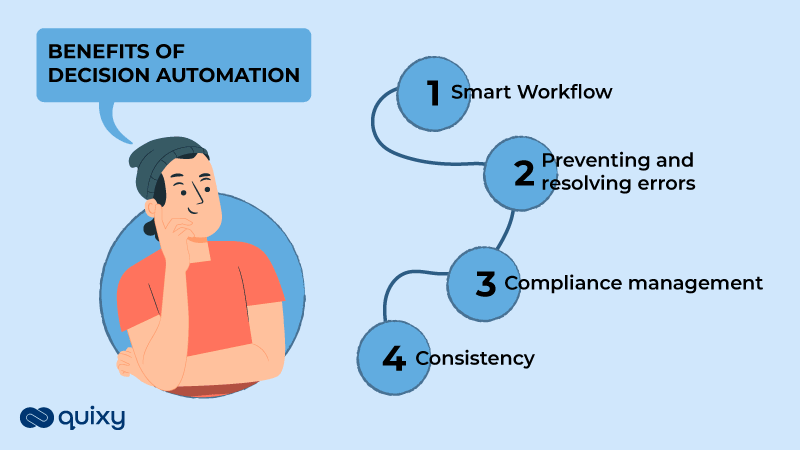
Small and large businesses need to make the right decisions within the timeframe they have, in a scalable way, to compete in today’s market. Technology is essential for decision automation, just as it is for search, transaction processing, and data management.
Data engineering and data science are two of the more recent additions to decision intelligence that bring together the legacy disciplines of systems/industrial engineering and operations research.
To solve real-world problems, companies can use decision intelligence transforming into digital-first organizations. A robust infrastructure is essential to the success of decision intelligence. Decision automation codifies decision intelligence principles into a set of standardized primitives that expose decision-making methods like optimization.
What is Decision Automation?
Using artificial intelligence, data analysis, and business rules, decision automation assists organizations in automating the decision-making process. In addition to increasing productivity, automated decision-making reduces risk and error. Consistency is maintained across all decisions, which is not found when it is left to an individual or group.
An organization’s daily operations are usually governed by routine and repetitive decisions. Organizations tend to make operational decisions that support their everyday operations.
How is Decision Automation Driven?
A business rule is a general guideline for operational decisions, which can be influenced or influenced by data. To automate a decision, business rules and data have to work together in a few advanced cases.
Automation of rule-based decisions
It is possible to automate decisions entirely using business rules. Routine and repetitive decisions are automated in many industries, including insurance, finance, banking, and so on, to ensure quality and consistency.
In the insurance industry, business rules automation can be used to automate underwriting, claims processing, pricing, discounts, etc.
In regulated environments, automating business rules becomes extremely important. The use of predefined business rules is particularly effective when the ‘explainability’ and reasoning behind certain decisions are crucial to customers, regulators, or other third parties.

Automation of data-driven decisions
Decisions may not be based on rules but rather on how a case in a particular situation is developing and if there is uncertainty about how the case will proceed. In the case of a car insurance policy, there is uncertainty about the riskiness of a driver. There is uncertainty about how the party will react to cross-sell offers.
When combined with rule-based decision automation, predictive models can work well in decision automation. In this way, any ambiguity in the decision-making process can be addressed.
Also read: Hybrid Workplace Model: The Future of Work
Benefits of Decision Automation
Automated decision-making can be used for a variety of purposes, but three main organizational problems can be solved by automating decision-making.

The smart workflow
As new information comes in from a range of interconnected data points, automated decision-making workflows must continuously adapt. The data points are selected based on their specific properties. Data points are analyzed based on changes in their properties to make automated decisions. Workflows become smarter when this happens seamlessly.
Preventing and resolving errors automatically
Using and knowing an automated workflow system, errors can be identified, repaired, or responded to without requiring human intervention. By automating these processes, errors can be spotted and corrected faster, resulting in faster and more robust systems.
Compliance with regulations and contracts
Regulatory compliance is also enhanced by automated decision-making. As an example, consider a theater’s audio setup. Decibel levels can be reduced to regulation levels by an automated decision if they reach prohibitive levels. Increasing compliance with business rules and industry regulations can be achieved through automated decision-making.
Consistent, fast, and error-free decisions
One of the main advantages is the ability to make quick, error-free decisions. The automated process also ensures consistency since it offloads the decision-making process from the human. By doing so, artificial intelligence can self-correct and take remedial measures without constant supervision. Every business decision is automated 24/7, removing any room for inconsistency or error as with business rule decisions are data-driven.
Also read: What is Collaborative Work Management? Top CWM Tools
Decision Automation Challenges
Involvement of humans
In an ideal decision automation process, some human input would be allowed along with a fully automated process. The drawback here is that it introduces a disconnected experience to the automation process. Consequently, there is no end-to-end view of everything needed to make a decision.
Controlling data
Decision automation applications require organizations to be agile while maintaining data control, retrieval, and storage. For auditing, this is essential. Managers need to constantly develop strategies to handle the influx of data generated by the Internet of Things, which is growing by the day.
Making multi-step and long-term decisions
There are some cases in which one decision may be dependent on the results of another related decision. A multi-step decision involves several steps. A long-running decision occurs when interdependent decisions are made one after another. There can be a lot of complexity and difficulty in following these.
Supporting automated decision-making environments
The business rationale is essential when deploying decision automation. It is also necessary to allocate adequate resources to them. It may be possible for poorly implemented systems to work against the organization’s purpose completely, creating unneeded decision criteria or integrating too many other sources of information.
How Quixy Can Help in Decision Automation
Quixy’s no-code platform is designed to simplify and streamline decision-making processes by automating repetitive tasks and enabling data-driven workflows. Here’s how Quixy can empower businesses with decision automation:
1. Rule-Based Workflows for Instant Decisions
Quixy allows users to create workflows with conditional logic, ensuring that decisions are made automatically based on predefined rules. For example:
- Approving loan applications if certain credit score criteria are met.
- Routing support tickets to appropriate teams based on the issue type or priority.
2. Integration with Data Sources
By integrating with various third-party applications and databases, Quixy ensures real-time access to critical information, which is essential for making accurate decisions. For instance:
- Pulling sales data to automate discount approvals.
- Accessing employee records for automated leave or expense approvals.
3. Custom Dashboards and Analytics
Quixy enables the creation of dashboards that consolidate data from multiple sources, providing decision-makers with real-time insights. This eliminates guesswork and allows for more informed, data-backed decisions.
4. Eliminating Manual Errors
Manual processes are prone to errors, which can lead to incorrect decisions. Quixy automates repetitive tasks, reducing errors and ensuring consistent outcomes in processes like compliance checks or procurement approvals.
5. Scalability and Adaptability
Quixy’s no-code approach makes it easy to update decision-making workflows as business needs evolve. Whether it’s adjusting criteria for risk assessment or incorporating new KPIs, changes can be implemented without coding expertise.
6. Empowering Citizen Developers
With Quixy, even non-technical users can design decision automation workflows. This democratizes the process and ensures that teams closest to the operations can create and refine automation tailored to their needs.
Real-Life Applications of Decision Automation with Quixy
- HR: Automated approval of employee requests, such as leave, reimbursement, or training nominations.
- Finance: Streamlining invoice processing and payment approvals.
- Customer Support: Automating escalations and ticket routing for faster issue resolution.
- Supply Chain: Ensuring inventory restocking decisions are based on predefined thresholds.
Quixy transforms decision-making by automating repetitive tasks, integrating real-time data, and enabling organizations to act faster and smarter.
Takeaway
Decision automation will eventually help organizations to make better quality decisions as these will be data-driven. Decision automation works more effectively in the case of repetitive operation decisions. Decision automation is an opportunity for organizations to leverage the power of technology to free up employees’ time for more focused work.
Subscribe
Login
Please login to comment
0 Comments
Oldest
















